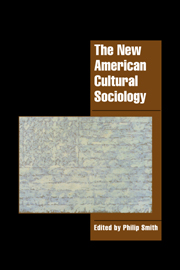Book contents
- Frontmatter
- Contents
- Notes on contributors
- Preface
- The new American cultural sociology: an introduction
- PART I Culture as text and code
- 1 Textuality and the postmodern turn in sociological theory
- 2 The computer as sacred and profane
- 3 AIDS and the discursive construction of homosexuality
- 4 Fundamentalism and liberalism in public religious discourse
- 5 Analytic and concrete forms of the autonomy of culture
- PART II The production and reception of culture
- PART III Culture in action
- Index
- Title in this Series
3 - AIDS and the discursive construction of homosexuality
Published online by Cambridge University Press: 18 January 2010
- Frontmatter
- Contents
- Notes on contributors
- Preface
- The new American cultural sociology: an introduction
- PART I Culture as text and code
- 1 Textuality and the postmodern turn in sociological theory
- 2 The computer as sacred and profane
- 3 AIDS and the discursive construction of homosexuality
- 4 Fundamentalism and liberalism in public religious discourse
- 5 Analytic and concrete forms of the autonomy of culture
- PART II The production and reception of culture
- PART III Culture in action
- Index
- Title in this Series
Summary
AIDS appeared during a period of significant change in Western sexual conventions. A series of movements in the sixties and seventies pointed in the direction of expanded erotic choice and tolerance for diversity. The women's movement struggled for women's erotic autonomy. Feminists demanded that women be able to define and control their own sexuality, and that included choosing a lesbian alternative. Less visible were the struggles by sexually disenfranchised groups like the elderly or the disabled to be accepted as full sexual beings. The counterculture made a more open and expressive eroticism a prominent part of its social rebellion. Furthermore, changes in our sexual norms that reflected long-term trends became evident. For example, the norm that sex is legitimate only as an act of love or a sign of relational fidelity was challenged. Sex discourses and representations (e.g., pornography, sex manuals, and radical sex ideologies) appeared that constructed sex as an autonomous sphere of pleasure and self-expression with its own intrinsic value and justification. A libertarian sex ethic accepted sex for its pleasurable qualities in any context of mutual consent and respect. This has expanded the types of relationships in which sex is permitted. Indeed, the exclusivity of marriage as the proper site for sex has given way to a more flexible convention that tolerates sex in varied relational settings. In short, while it would be misleading to assert that a revolution occurred, there did transpire important changes in our sexual norms and behavior during this period.
Indicative of this more liberal sexual culture was the increased tolerance for homosexuality. By the mid-seventies gay sub-cultures were visible in virtually every major urban center (Altman 1983; D'Emilio 1983).
- Type
- Chapter
- Information
- The New American Cultural Sociology , pp. 47 - 59Publisher: Cambridge University PressPrint publication year: 1998

